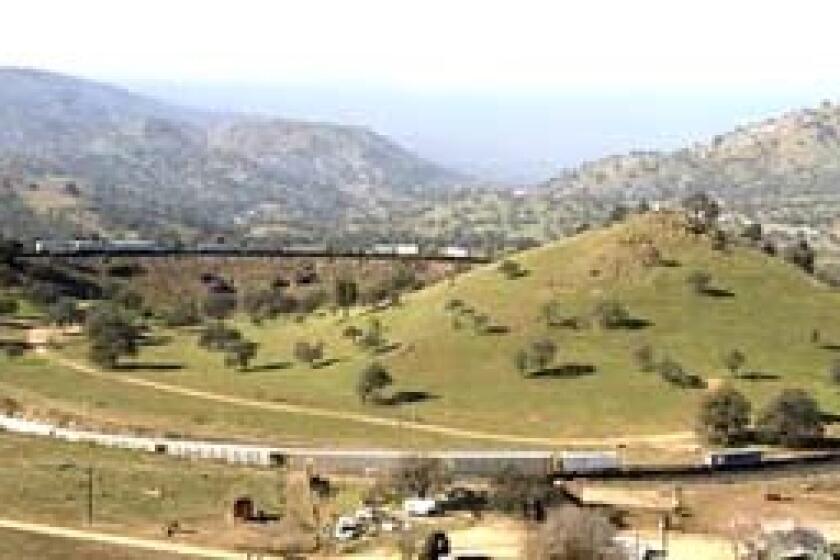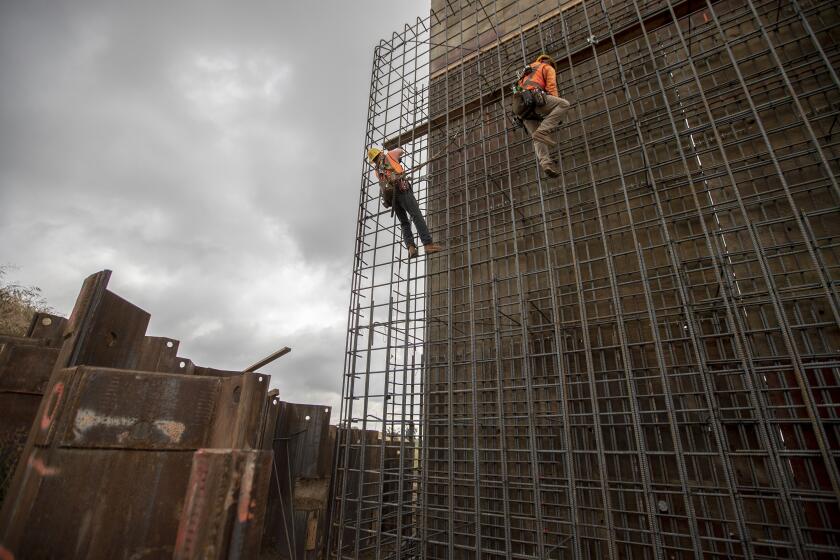Bullet train would nick jobs, homes and parks on 14-mile route from L.A. to Burbank
The future California bullet trainâs passage from Burbank to Los Angeles would follow an existing 14-mile rail corridor, cross 22 roads, traverse the Los Angeles River, run through dozens of businesses and hit people across economic and racial segments, a draft environmental study found.
The Los Angeles segment would create two electrified high-speed rail tracks and two conventional tracks for diesel trains from an underground platform in Burbank to Los Angelesâ historic Union Station at an estimated cost of $3.6 billion, according to the report, which was released late Thursday afternoon by the California High-Speed Rail Authority.
Exactly when the future route might be built is unknown because the state lacks the funds to build most of the system from San Francisco to Los Angeles. But under a federal grant, the state must complete all of the environmental impact statements and reports for various segments by 2022, disclosing the exact routes, economic effects and social jolts that would occur at some future date.
The state is currently pursuing a plan to build a 171-mile bullet train starter system from Bakersfield to Merced in the Central Valley at a cost of $20.4 billion, which will consume all of its funds through 2030.
Assembly Speaker Anthony Rendon (D-Lakewood), joined by other Southern California legislators, has proposed to reduce bullet train spending in the Central Valley by delaying a $5-billion electrical system and invest the money in the bullet train corridors in Southern California, including the Burbank to Los Angeles segment, and the Bay Area.
It would bring greater passenger ridership and reductions in emissions sooner, Rendon said. But Gov. Gavin Newsom and high-speed rail executives are holding firm on the current plan.
What began as a vision to build a $33-billion train that would rocket through the state at 220 miles per hour from Los Angeles to San Francisco has bogged down to a plan, costing $80 billion or more, with an uncertain end date.
Costs keep climbing for a challenging section of the California high-speed rail route â one that currently lacks a funding source but is crucial for getting trains to Los Angeles.
At an Assembly Transportation Committee hearing on Wednesday, Chairman Jim Frazier (D-Discovery Bay) was clearly frustrated with the performance of the top bullet train executives, saying that their reports are âmisleading or downright not trueâ and that the project should hit the âpause buttonâ to reevaluate its future.
The environmental reports, however, reiterate the need for the rail.
âThe capacity of Californiaâs intercity transportation system, including in the cities of Burbank, Glendale, and Los Angeles, is insufficient to meet existing and future travel demand,â the document summary says, adding that the project could help ease projected future congestion, air pollution and increased travel times.
The Burbank to Los Angeles section is among only several locations where the future train would travel on an existing railroad right of way. The path was once part of the empire of Southern Pacific, the railroad that shaped the Los Angeles region from the late 1800s, but was turned over to local government and is now used by Metrolink and Amtrak, as well as freight railroads.
The plan includes a major renovation of Union Station, replacing the stub tracks that force trains to back in and out of the station with 10 new run-through tracks â cutting significant amounts of time off the schedule. The station would have two electrified high-speed tracks served by an 870-foot passenger platform.
The trainsâ route as they exit the station would be part of the Los Angeles to Anaheim environmental report. The alignment would be an engineering feat, requiring the tracks to leap over the 101 Freeway, take a sharp left turn near Little Tokyo for about 1,000 feet and then take a sharp right along the Los Angeles River.
The Burbank station, meanwhile, would be located east of the Hollywood Burbank Airport on 70 acres, parallel to Hollywood Way. A technical appendix of the documents indicate the tracks would travel through a tunnel under an airport runway, avoiding an above-ground protection zone set by the Federal Aviation Administration. The tracks would return to the surface south of the airport.
The environmental documents indicate the construction will displace 19 individuals in Burbank and 15 in Los Angeles, involving 12 residential buildings in the two cities.
The route would also take out 84 commercial, retail and industrial businesses that employ 1,747 people.
The draft environmental study outlines impacts that are significantly less problematic than the route from Bakersfield to Palmdale, which the rail authority described in February.
The Bakersfield to Palmdale section would take out the R. Rex Parris High School in Palmdale, the Lancaster Community Homeless Shelter, the Solid Rock Bible Church, eight motels, 253 residential housing units, 311 businesses and 175 farm fields.
Opponents of the stateâs high-speed rail project say California is preparing to violate a 2008 ballot measure promise not to use state subsidies for operation of the bullet train. Proponents disagree.
The new 14-mile route would cut through Burbank, Atwater Village, Glassell Park, Greater Cypress Park, Lincoln Heights and Arroyo Seco. The report finds that construction would cause âsignificant and unavoidableâ impacts from emissions that would exceed thresholds for sensitive individuals and children. Noise impacts from high-speed train operations could require sound walls, it notes.
It would also cause serious impacts on a proposed San Fernando Railroad Bike Path project. It would affect bus lines and traffic. The impacts would be borne by minority and low-income residents, but not disproportionately, it found.
The route would take about a half acre in the Rio de Los Angeles State Park and somewhat less in the Albion Riverside Park.
But it would create 3,600 new construction jobs, a small increase over what would occur if the rail were not built at all, according to the study.
Public comment on the environmental reports is open until July 16.
More to Read
Sign up for Essential California
The most important California stories and recommendations in your inbox every morning.
You may occasionally receive promotional content from the Los Angeles Times.













